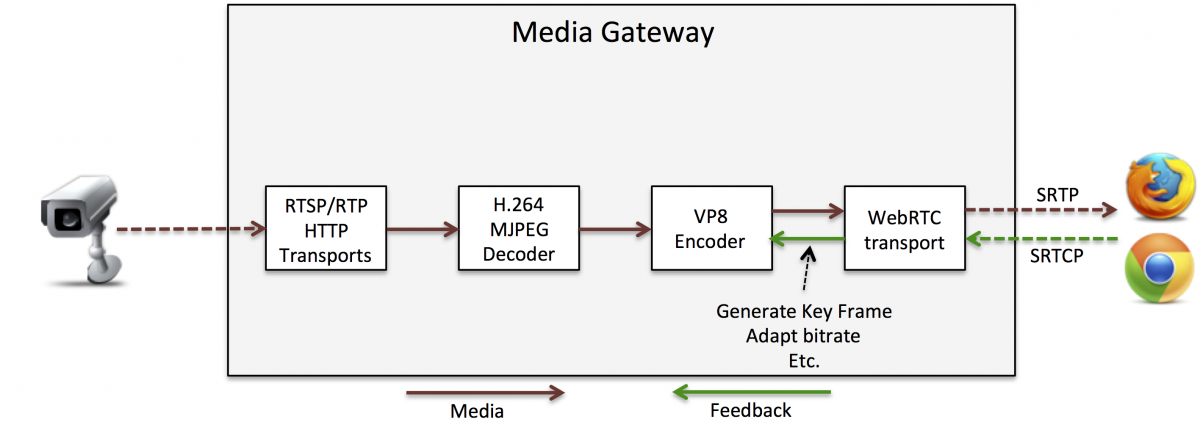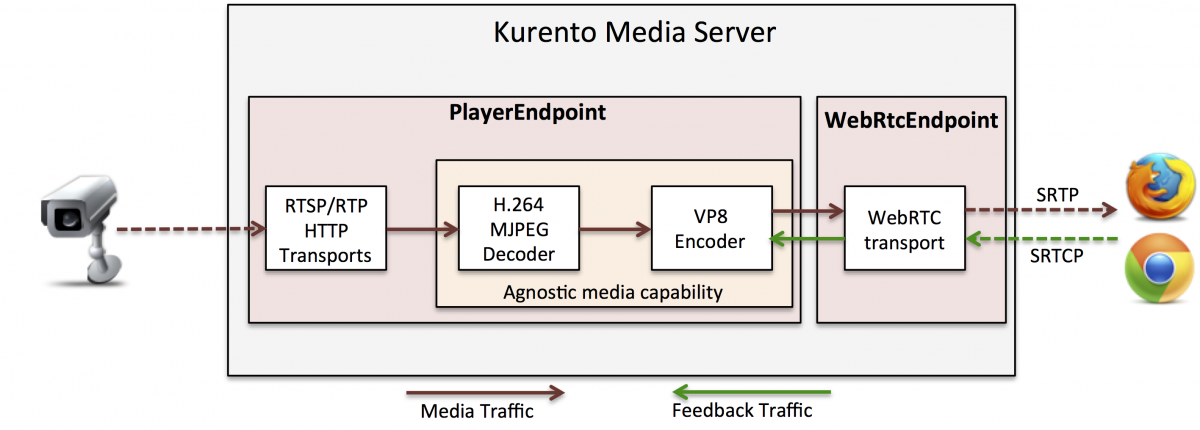In the last few months, an increasing number of developers are asking for information on how to integrate IP video cameras with WebRTC. Solving this problem requires, in general, a lot of plumbing and deep knowledge about low level details of media protocols. Moreover, the distance between making "just a demo" and making a production-ready application is huge. In this post, we try to explain how to do it right with Kurento Media Server.
WebRTC Media Gateways for media interoperability
To integrate an IP camera with a WebRTC application you first need to achieve media interoperability, i.e. the media stream provided by the camera needs to be made compatible with the WebRTC codecs and formats supported by browsers. This means to translate whatever the IP camera speaks into whatever the WebRTC browser supports. For this to happen, typically a piece of technology called a WebRTC Media Gateway is required.
Most IP cameras available in the market (excluding exotic ones) publish media through any of these mechanisms:
- RTSP/H.264: These types of cameras are typical for video surveillance applications. They use the RTSP protocol for establishing an RTP media session. In other words, signaling takes place through RTSP while media transport itself is based on plain RTP. Different camera vendors may support different RTP profiles, but most cameras only come with AVP. In these cameras, and also typically, H.264 is the only option for the codec.
- HTTP/MJPEG: These cameras use HTTP streaming for signaling and transport and encode video as a sequence of JPEG pictures. The hardware for these cameras is simpler and requires less resources to operate. This is why they are often used when battery consumption or weight are an issue (e.g. robotics, drones, etc.) As a drawback, the video quality tend to decrease significantly.
So, to achieve WebRTC interoperability the media gateway requires implementing the media management procedures as shown on Figure 1. As it can be seen, the gateway requires first the ability of speaking the camera language (i.e. RTSP/RTP or HTTP), decoding the video stream received from the camera (i.e. H.264 or MJPEG), re-encoding it again to VP8 (the most common coded for WebRTC) and sending it to the WebRTC client using the WebRTC protocol stack.

Dealing with the network: making a production ready application.
For having a production ready application dealing with media adaptation is not enough. You need also to manage with how real networks work. For doing so, the WebRTC protocol stack uses the SAVPF profile, where the final 'F' means "Feedback". This feedback consists on RTCP packets that, in the scenario depicted on Figure 1, are sent from the WebRTC client to the gateway with information about the network conditions that may affect quality.
As explained above, most IP cameras only support AVP (without the 'F') meaning that the gateway cannot just propagate the feedback to the camera (i.e. as happens in many SFU architectures) but needs to be fully manage it. In the jargon, we say that the gateway must terminate the RTCP feedback.
This is the critical point. You must be certain that the WebRTC gateway you are using is really and fully terminating and providing semantics to the RTCP traffic. The symptoms you can perceive when the RTCP traffic is not terminated are devastating for the perceived quality of service: basically the video freezes.
To understand why video freezes, lets analyze what happens when the gateway does not terminate two simple types of feedback RTCP packets: PLI and REMB.
- If the gateway does not have the ability of managing PLI RTCP requests the video shall freeze randomly as soon as the network is having packet loss. This happens due to how the VP8 encoder works. It may not generate key frames during long time periods (typically minutes). Every time a PLI packet is not managed by the gateway by generating a new key frame, the WebRTC client shall not be able to decode until a new periodic key frame arrives (again, this can take minutes). A trick used by some gateways to solve this is to generate key frames with high frequency (e.g. once every two seconds) but this degrades significantly the video quality of the VP8 codec given that VP8 key frames consume significantly more bandwidth.
- If the gateway does not manage REMB RTCP requests and does not take into consideration any kind of congestion control mechanism, the gateway will not react to congestion commanding the VP8 encoder to decrease its bitrate. This means that, as soon as the connectivity link between the gateway and the WebRTC client is congested, the WebRTC browser shall be overloaded with video traffic and relevant packet losses shall take place, driving again to degraded quality of experience and video freezing.
Doing it right with Kurento Media Server
The Kurento Media Server toolbox makes possible to create rich WebRTC Media Gateways in a flexible way and programming in Java or JavaScript if you want. For an introduction on Kurento Media Server technologies, just take a look to the documentation. Implementing a WebRTC Media Gateway for interoperating with IP cameras in Kurento is trivial and safe. You need only take into consideration three aspects:
- Kurento Media Server's PlayerEndpoint supports reading video streams from different types of sources including RTSP/RTP and HTTP/MJPEG. In other words, the PlayerEndpoint is capable of managing the capture of media from the IP camera.
- Kurento Media Server WebRtcEndpoint supports publishing media streams to WebRTC browsers with full termination of RTCP feedback. This means that, every time a PLI packet is received, the WebRtcEndpoint shall command the VP8 encoder to generate a new key frame. This also means that REMB feedback and congestion control shall be honored by commanding the VP8 encoder to decrease its quality.
- Kurento Media Server agnostic media capability performs all the required codec transformations (usually called transcoding) in a way that is transparent for the developer. Hence, in this case, just by connecting the PlayerEndpoint source to the WebRtcEndpoint sink, the H.264/MJPEG to VP8 transcoding will take place.

As shown on Figure 2, creating the WebRTC Media Gateway for interoperating RTSP/H.264 and HTTP/MJPEG cameras with WebRTC is trivial. The source code of a JavaScript application implementing this logic is sketched below:
var pipeline = ...//Use Kurento Client API for obtaining your pipeline. //Create the PlayerEndpoint for receiving from the IP camera. HTTP and RTSP uris are supportd pipeline.create("PlayerEndpoint", {uri: "rtsp://your.rtsp.address"}, function(error, playerEndpoint){ //Create the WebRtcEndpoint pipeline.create("WebRtcEndpoint", function(error, webRtcEndpoint){ //If working with trickle ice, some code for candidate management is required here. //Connect playerEndpoint to webRtcEndpoint. This connection activates the agnostic media //capability and the appropriate transcodings are configured and activated. playerEndpoint.connect(webRtcEndpoint, function(error){ //Media starts flowing ... enjoy player.play(function(error){ }); }); }); });
If you want a fully working example for all this, you should have a look at the official Kurento Player tutorial for Java. There is also an externally contributed example (albeit unmaintained) written in JavaScript, in this GitHub repository .
The beautiful point of all this is that adding further capabilities to your gateway, such as recording or even video content analysis, is still quite simple given that you just need to instantiate the appropriate media elements and connect them following the desired media topology. This is the advantage of working with Kurento: modularity.
Do you have any experiences using Kurento for interoperating WebRTC with IP cameras? Please share them with us!
Best and happy code.

